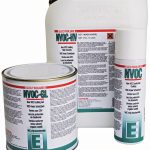Newly manufactured and cleaned printed circuit boards will generally perform well electrically, but performance will quickly deteriorate due to adsorption of atmospheric moisture, contamination of the surface with airborne ionic material, electrostatic attraction of dust to the surface etc. Conformal coatings are designed to protect printed circuit boards and related equipment from their environment. These coatings conform to the contours of the board allowing for excellent protection and coverage, ultimately extending the working life of the PCB. The use of conformal coatings is important in many industries, such as military, aerospace, automotive and industrial applications, to name just a few.
Jade Bridges, R&D Manager, Electrolube Ltd
Traditionally, the most widely used conformal coatings tend to be solvent based and are available in several distinct chemical types; acrylic, silicone (conventional and silicone alkyds), epoxy and polyurethane. The properties of a conformal coating stem from the selected base resin and the various additives included optimising the performance of the cured coating. Organic solvents are used to dissolve the base resin and reduce viscosity to bring the coating within a workable range. As such, the coating dries by a simple solvent evaporation and in some cases can be further heat or moisture cured to initiate cross linking, further enhancing the coating properties.
The solvents used in these conformal coatings are classed as Volatile Organic Compounds or VOCs and typically account for 50 to 75 % of the overall formulation. VOCs are carbon based compounds which vaporise easily at room temperature, contributing towards the formation of ground level ozone, a major component of smog. They are more clearly defined by the EU Solvents Emissions Directive, which states that a VOC is “any organic compound having at 20° C a vapour pressure of 0.01 kPa or more, or having a corresponding volatility under the particular conditions of use.” Alternatively, the EPA definition is as follows: „’Volatile organic compounds (VOC) means any compound of carbon, excluding carbon monoxide, carbon dioxide, carbonic acid, metallic carbides or carbonates, and ammonium carbonate, which participates in atmospheric photochemical reactions.”
Application requirements fulfilled
Electrolube released a new conformal coating, NVOC (Non-VOC Coating), to the market in 2007 in order to meet the demanding requirements set down by the EU Solvent Emissions Directive. Today, it is still the only coating to offer a drop-in replacement for solvent based materials in selective spray applications and is now also available in a range of formats, covering all application requirements. NVOC is based on polyurethane technology. It utilises a polyurethane pre-polymer as the base resin; a 100 % solids material in the form of a high viscosity liquid. The pre-polymer is pre-reacted polyurethane and isocyanate where some of the functional groups are blocked. Upon exposure to moisture the reaction continues to completion, forming a tough, even coating.
NVOC has been created by adapting the polyurethane pre-polymer with a blend of carefully chosen diluents to ensure that all materials are reacted within the system. The diluents chosen offer a massive reduction in viscosity creating a 100 % solids material at a sprayable viscosity, similar to that of solvent based materials but without the emission of any VOCs. The cure profile starts with the polyurethane pre-polymer reacting with moisture in the air. This is then followed by a further reaction with the diluent blend, releasing only carbon dioxide from the reaction. Due to the cure profile of the coating, heat can also be used in conjunction with atmospheric moisture to accelerate the reaction. The cross-linking nature of this coating means that the mechanical strength and abrasion resistance properties are excellent. The cured coating therefore is extremely tough and possesses excellent moisture and chemical resistance, meeting and far surpassing the requirements of many of the top industry standards for conformal coating.
Due to the reaction profile of NVOC it is supplied in a ready to use formulation for spraying applications. It has been tested by the worlds’ leading manufacturers of select spray equipment with extremely positive results in a variety of technologies, including film, swirl and atomising coating techniques. It has been shown that it is possible to apply the new coating via conventional methods and with little change to the set up parameters. The coating can then be cured at room temperature or accelerated by the use of an IR or conventional oven, without any delay. NVOC offers the performance and ease of use of a solvent based coating and in addition supplies users a ready-to-use material with no evaporation loss. Therefore the same amount of coating will spread much further than a solvent based material and does not require costly extraction processes.
Coating methods
The company have now expanding the NVOC range, offering solutions for a variety of coating application methods. Firstly, a 200 ml aerosol version (ENVOC200H) utilises the standard NVOC coating to provide an easy solution to manual, small-scale or rework applications. It utilises a carefully selected propellant which also offers many environmental benefits over alternative technologies. The propellant is 100 % ozone friendly, with an Ozone Depleting Potential (ODP) of zero. It also has a negligible Global Warming Potential (GWP) of <5, which is extremely low in comparison with alternative propellants with GWP >1000.
A high viscosity version (NVOC-HV) has also been developed for applications where a thicker coating or manual application is required. These include, brush, dip and high viscosity selective spray applications; both the standard NVOC and the high viscosity version are suitable for atomising and swirl selective coat applications. The product has been created utilising the same chemistry as the standard NVOC and therefore offers the same high performance characteristics. The difference is in the level of diluents, which has been carefully adjusted to provide a coating of optimum viscosity for higher build applications.
Finally, a gel version (NVOC-GL) offering a single part, semi-thixotropic material designed for glob-top applications where the coating should not flow once applied. The semi-thixotropic gel cures at room or elevated temperatures upon exposure to atmospheric moisture and incorporates a UV trace to aid inspection. It is ideally suited for applications where components are difficult to coat due to size, shape and position. When used in conjunction with the standard NVOC it is ideal for dam and fill an application; as the chemistry is the same for both materials, the gel does not need to go through a separate cure stage to the coating and therefore both materials can be cured together, immediately after application.
NVOC offers many advantages over other coatings on the market. Now available in a variety of application types, this novel range of conformal coating products offers the complete environmentally friendly solution for conformal coating. Therefore it can be said that the development of the NVOC range has led to a new era in conformal coating. Over time, regulations will get tighter and the use of solvent based conformal coatings will lessen as the industry norm. With this continual expansion of their range, Electrolube have simplified the transition away from solvent based materials and aid conformal coating users in reducing their solvent use, thus paving the way towards a greener future within the industry of conformal coating.
Share:












